 Durban Club token
(Natal):
Durban Club token
(Natal):
| In 1852 the Durban Quoit Club was formed. Two years later
this developed into the Durban Club which arose in the first instance for
the purpose of playing billiards. The purpose of the Durban Club tokens was
to supplement the acute shortage of small change. The value of the token
is believed to relate to the cost of playing billiards at the club.
Source: The Tokens of Natal, Pat Moran There are three coins in the set - all owned by the Balson Holdings Family Trust - see images below . Four of these extremely rare token coins were purchased in from the Durban Club. |
 Durban Club token
(Natal):
Durban Club token
(Natal):
NOTE: The success of the Durban Club 6d is attributed to the launch of South Africa's first indigenous coinage, the Strachan and Co trade tokens
Very Rare (Fuld) Rarity Scale: R - 6).
It has taken 30 years fro the Balson Holdings Family Trust to acquire these coins - the last piece being the original pattern coin with a brass overlay and totally unique. (Fuld) Rarity Scale: R-10. (The brass coating is missing from the surface in places as can be seen in the scans).
The first two pieces displayed below - Milled and Plain edge are the finest Durban Club 6d pieces known.
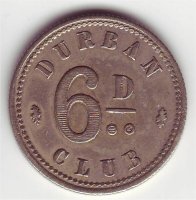 |
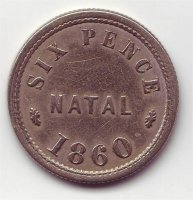 |
Milled |
Edge |
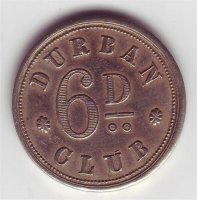 |
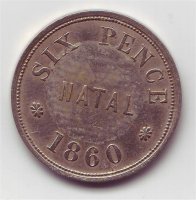 |
Plain |
Edge |
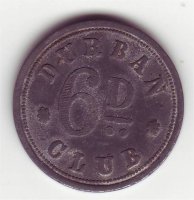 |
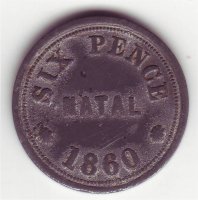 |
White |
Metal |
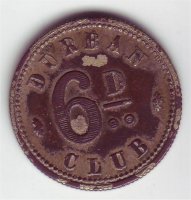 |
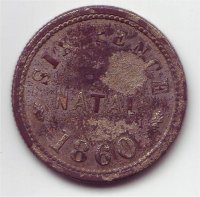 |
The unique brass |
pattern piece*. |
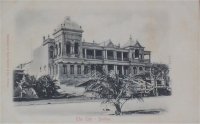
Value in 2006: The Durban Club 6d tokens are highly sought after and trade and are rarely seen on auction. The tokens sell for over US$1,000 in VF condition. The pattern piece is unique - all Durban Club 6d tokens stem from this piece.
The scarcity of the pieces above is demonstrated by the fact that it has taken the Balson Holdings Family Trust thirty years to acquire them.
Images right: the Durban Club in 1906 - sketch on a postcard. The same elegant building survives today.
The rare Durban Club six pence was issued in 1860 the three known known varieties according to Dr Theron, Pat Moran, E J Maynard, Hern and others are displayed above. These varieties include: a token with a milled edge, a plain edge and a white metal token.
From our research we suggest the tokens were issued over a number of years using the original 1860 dies.
The pattern piece in the Balson Holdings Family Trust collection supports our view that:
The evolution of the Durban Club:
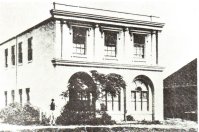 |
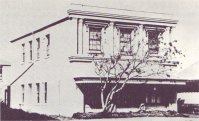 |
 |
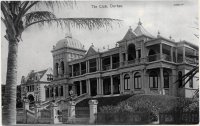 |
c 1863 |
c 1871 |
c 1881 |
c 1904 - cost £21,850 |
The impact of the Durban Club tokens on S Africa's first indigenous coinage
It was the successful circulation of the Durban Club 6d that led to the Umzimkulu
trading firm Strachan & Co circulating
their own coins which became South Africa's first indigenous currency. Margaret
Rainier notes on page 150 of her book
 "Madonela"
that Donald Strachan stayed at the Durban Club when he visited Durban and
Ken Strachan (the trading firm's Managing Director in the 1970s) noted that
his great grandfather had based the release of his coins on the success of
the Durban Club 6d.
"Madonela"
that Donald Strachan stayed at the Durban Club when he visited Durban and
Ken Strachan (the trading firm's Managing Director in the 1970s) noted that
his great grandfather had based the release of his coins on the success of
the Durban Club 6d.
The Durban Club is the city's premier club today, located in a prime position overlooking the bay. Its origins in 1854 apparently began (according to George Russell the author of "History of old Durban") when a small group of quoits players established a small grassy patch near the bay on which to play their favoured game. Later a billiards table was purchased and the club simply blossomed from there on. Pat Moran's book on tokens in Natal also gives loads of interesting background information on the Durban Club and famous Durban Club 6d.
The historic Durban Club notes:
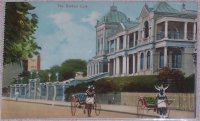 The Durban Club was founded on
the 14th June 1854 for gentlemen to meet over a game of billiards. The second
clubhouse was erected by the Durban Club Building Company in 1863. Building
operations for the third clubhouse started in October 1900 and were completed
in the grand Edwardian Tradition in 1904. In 1936 improvements and additions
comprising 23 bedrooms, a new bar and private dining room were constructed.
During 2001 and 2002 a programme was undertaken to restore the Club's function
rooms to their original splendour, and to update the accommodation facilities.
(Scott Balson's family knew Derek De Haaff, the manager of the
Durban Club in the 1970s, very well and visited it quite a few times.)
The Durban Club was founded on
the 14th June 1854 for gentlemen to meet over a game of billiards. The second
clubhouse was erected by the Durban Club Building Company in 1863. Building
operations for the third clubhouse started in October 1900 and were completed
in the grand Edwardian Tradition in 1904. In 1936 improvements and additions
comprising 23 bedrooms, a new bar and private dining room were constructed.
During 2001 and 2002 a programme was undertaken to restore the Club's function
rooms to their original splendour, and to update the accommodation facilities.
(Scott Balson's family knew Derek De Haaff, the manager of the
Durban Club in the 1970s, very well and visited it quite a few times.)
The excellent book on the "Tokens
of Natal" by Pat Moran gives far greater depth into the history of these
token coins. See also the Pietermaritzburg Franklin
Penny.
A Durban Club invoice dd 17th November 1900 notes a debt of nearly twelve pounds by a Col Bayley. This invoice is in the Balson Holdings Family Trust collection.
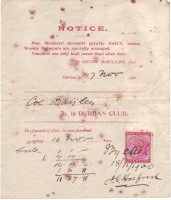 The Durban Club today is but a shadow of its former glory with a much reduced membership - although much of the grandeur of old club remains - including a fabulous dining area. The violence that
now reigns in post-1994 South Africa has effectively hamstrung the club down because of its location in central Durban.
It was purchased in the dawn of the 21st Century by a young black female
doctor and is still laden with furnishing and memorabilia representing its
historic past.
The Durban Club today is but a shadow of its former glory with a much reduced membership - although much of the grandeur of old club remains - including a fabulous dining area. The violence that
now reigns in post-1994 South Africa has effectively hamstrung the club down because of its location in central Durban.
It was purchased in the dawn of the 21st Century by a young black female
doctor and is still laden with furnishing and memorabilia representing its
historic past.
Earlier, in the 1980s Scott Balson briefly stayed there when his school friend's father, Derek De Haaf, was the manager.
The Durban Manor (accommodation) today - shadow of its past
While the magnificent past is still apparent the degridation of the Durban Manor "hotel" is somewhat apparent. The accommodation now offered is sub standard as Scott found out when he returned to this boutique hotel attached to the Durban Club in 2006. The old gentry of years gone no longer walk its hallowed halls in the evenings and the bar does not need a barman as it is empty. The black gangs who wait outside in the streets of Durban to empty the pockets of the affluent have made sure of that.
The images below were taken during Scott's brief stay at a historic
location once frequented by some of South Africa's most prominent personalities
of the past.
It is unclear what the future of the club building is as it has been sold. It might be torn down to be replaced by yet another
set of apartment blocks under a new regime. Ironically the new owner is rumoured to be Robert
Mugabe - President of Zimbabwe - how Cecil Rhodes would turn in his grave!
The Durban Club history by David Bennett - from the official web site. History transcribed below:
Durban, on the Bay of Natal (or Port Natal) was first settled in May 1824 by a small group of (mainly British) hunters and traders under the leadership of Henry Francis Fynn, Lt. James Saunders King and Lt. Francis George Farewell.
At a meeting (August 1824) between Fynn and Farewell, and the Zulu King, Shaka, a land grant, some 2500 square miles in extent, was made by Shaka to the settlers of the area around the Bay of Natal, that is to F.G. Farewell & Co., and on 27th August 1824, Farewell hoisted the Union Jack and took possession of the land in the name of the British Crown, who, at that time, was King George IV. The area so granted was “25 miles to the north of the Bay, 25 miles to the south of the Bay, and 50 miles inland”.
By the mid 1850s D’Urban (as it was then called) was a thriving centre of trade on the east coast and the town was proclaimed as a Borough (15th May 1854) by the Lt. Governor, B.C.C. Pine, with an official population of 1,204. Three months later, on 2nd August, eight members were elected to the first town Council, with George Christopher Cato as the first Mayor. The Agreement to form the Durban Club was signed by a group of the Town’s gentlemen on 14th June, 1854, thus making the Club one of South Africa’s oldest Clubs, if not the oldest Club. The Agreement began “ We, the Undersigned, hereby agree to form a Club to be called the D’Urban Club for the purpose of playing at Billiards, Chess and as a Reading and News Room………..”. In fact the Club can trace its origins back a further two years, when, in about June 1852 the Durban Quoits Club was formed, but two years later the gentlemen of that Club desired a less strenuous activity, and they formed the Durban Club, and transferred the assets of the Quoits Club (£4.5.4) over the Treasurer of the newly formed Club.
From very humble beginnings, and two earlier Club buildings, the present (and third) building housing the Club was started in 1900, and completed in 1904, in grand Edwardian style (more specifically Baroque Revival), which was very popular at that time. The building was then described as being “one of the Town’s most exquisite buildings” - an accolade still true today. Indeed, the Club building is a listed building and a famous landmark in the City.
Having passed through the Anglo-Zulu War of 1879, the First (1889) and Second (1899-1902) Anglo-Boer Wars, the Zulu Rebellion (1906), the Great War of 1914-1918 and the Second World War (1939-1945) the Club has hosted more than its fair share of famous personages, including George Cato; Prince Louis Napoleon; Thomas Baines; Cathcart Methven; Lord Chelmsford; Sir Garnet Wolseley; General Sir Henry Evelyn Wood, V.C.; General Sir Redvers Buller, V.C.; General Lord Roberts, V.C.; General Sir Robert Baden Powell; Sir Winston S. Churchill; Rt.Hon. Lord Milner and Field Marshal Earl Douglas Haig.
Of course many of Durban’s leading early citizens, including many Mayors of Durban have been members of the Club. Some early members whose names are famously associated with the City, include: Henry Francis Fynn; J.R. Saunders; Richard (****) King; John Dunn; Sir John Robinson; Sir Theopolis Shepstone; J. Ellis Brown and W. H. Acutt. So too are many of the famous families who built huge business empires in Durban, including: Baumann; Campbell; Crookes; Forsdick; Grindrod; Hepburn; Hulett; Marriott; McCarthy; Renaud; Rennie; Saunders and Shave.
There was a time, when the waters of the Bay came almost to the front boundary wall of the Club property; now, through reclamation, a double highway, footwalks and a railway line separate them. Women were first allowed to set foot regularly³ in the Club only in 1904, when members voted (by 61 – 8) to allow ladies into the Club on one evening per month. Of course things have changed a great deal since then and naturally, ladies are welcomed at the Club, including as members.
Some famous men are honoured by the Club through their names. The main dining room is named for Lord Louis Mountbatten, whilst two of the function rooms are named the Churchill Room and the Jan Smuts Room. Within the walls of the Club are some beautiful pieces of furniture, paintings and other memorabilia, historical items and silverware. Once in the Club, the ambience and history will be immediately apparent to any visitor.
In recent times, through the increasing decentralisation of the inner city area, many businesses have moved to the suburbs, and the need for a Club, as large as it was in the period between 1960 and 1990, has diminished. It was agreed in 2002 to sell the Club building, to a business called Durban Manor, and the Durban Club leased back, for a period of 99 years, a smaller part of the building, more appropriate to members’ needs, which presently forms the Durban Club of today.
Article on the Durban Club Token Coins at
this link
[1815/16 Griqua Town "coins"]
[1860: Durban Club 6d] [1862
Durban Bank £5 Bank Note] [1868: Griqua £1
Bank Note]
[1874: Mount Currie Express Stamp]
[1874/1932: Strachan and Co Currency Tokens]
[1876 Pietermaritzburg Franklin Penny]
[Other E Griqualand Tokens]
[1870s Griqua Town
Patterns] [1890: Griqua Patterns]
[Other Serious Griqua Coin Collectors]
[The History of the Griqua People]
[Griqua Token Coins, Coins and Bank Notes]
[Web Site Text Site Map]
[Tokencoins.com Home Page]
[Other South African Metal Token Coins]